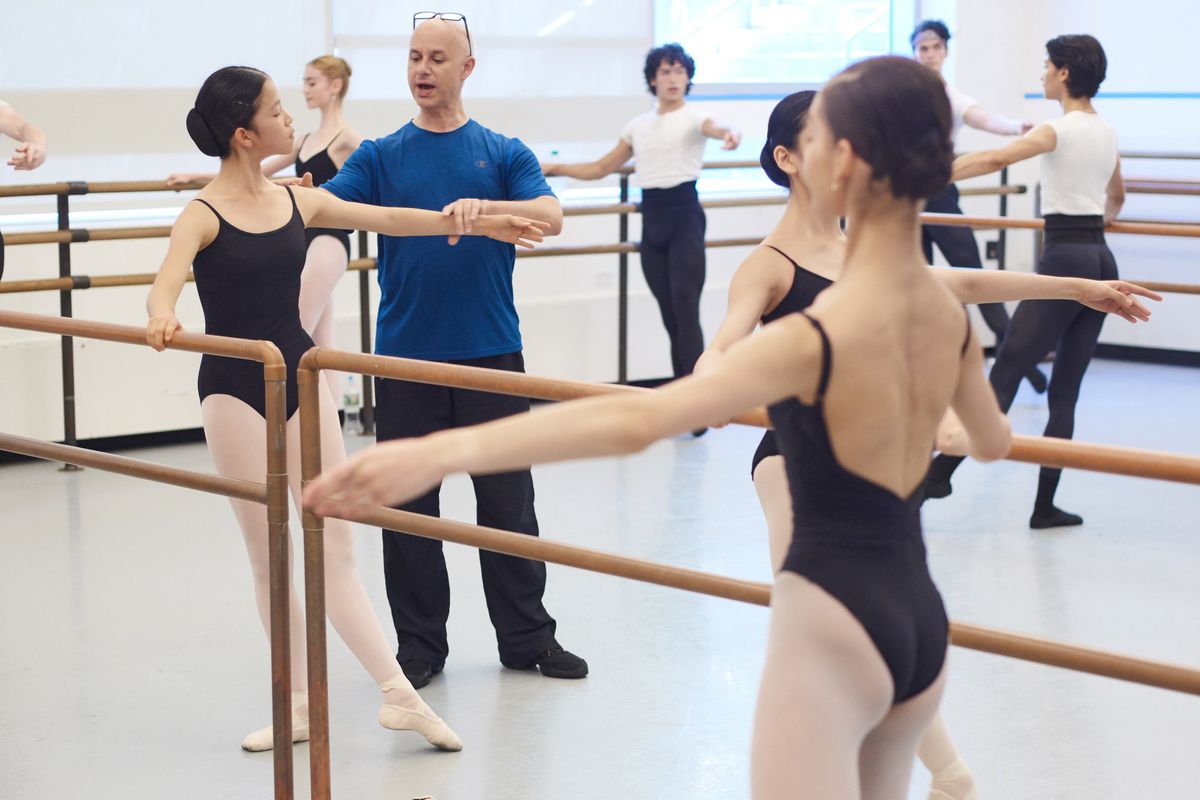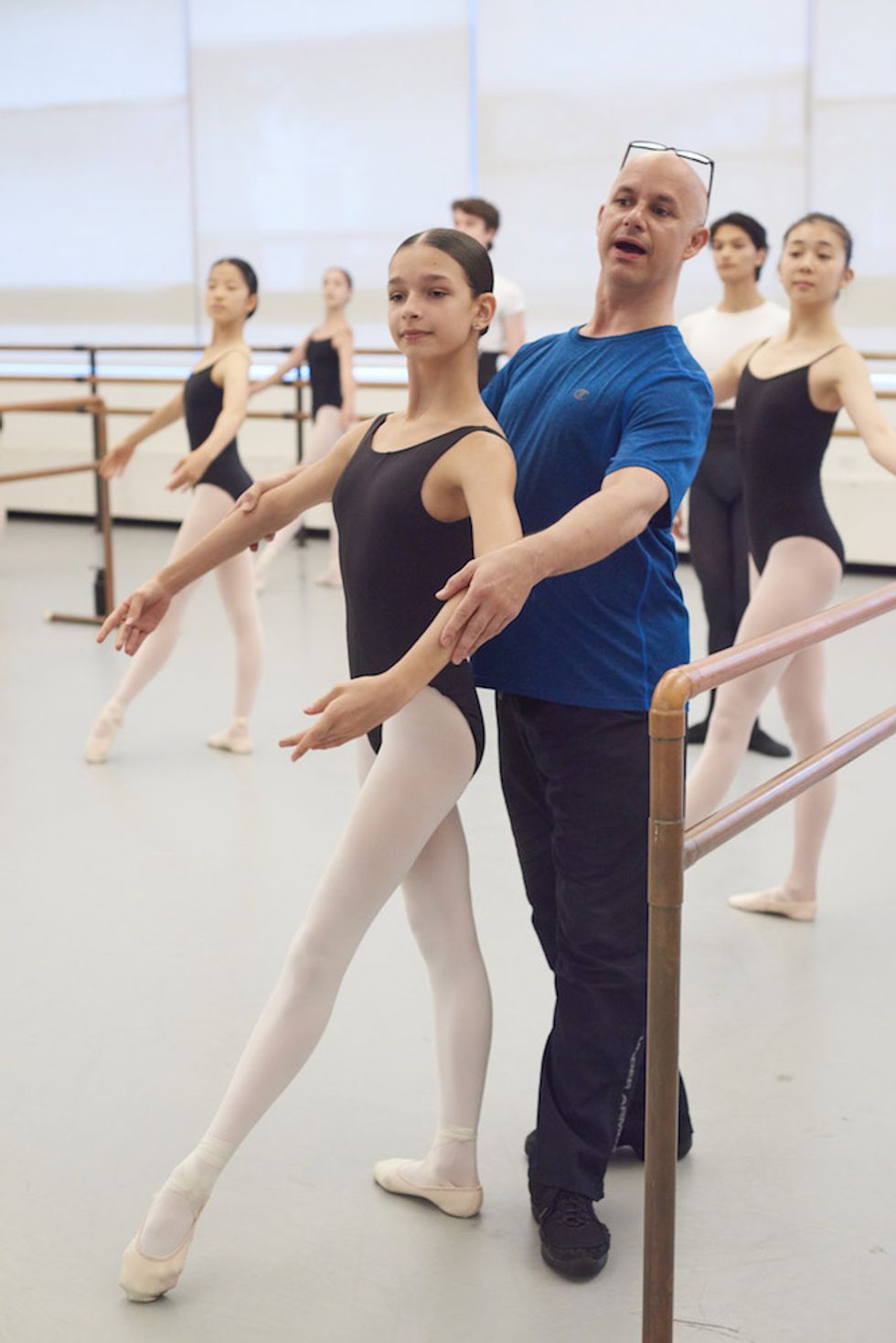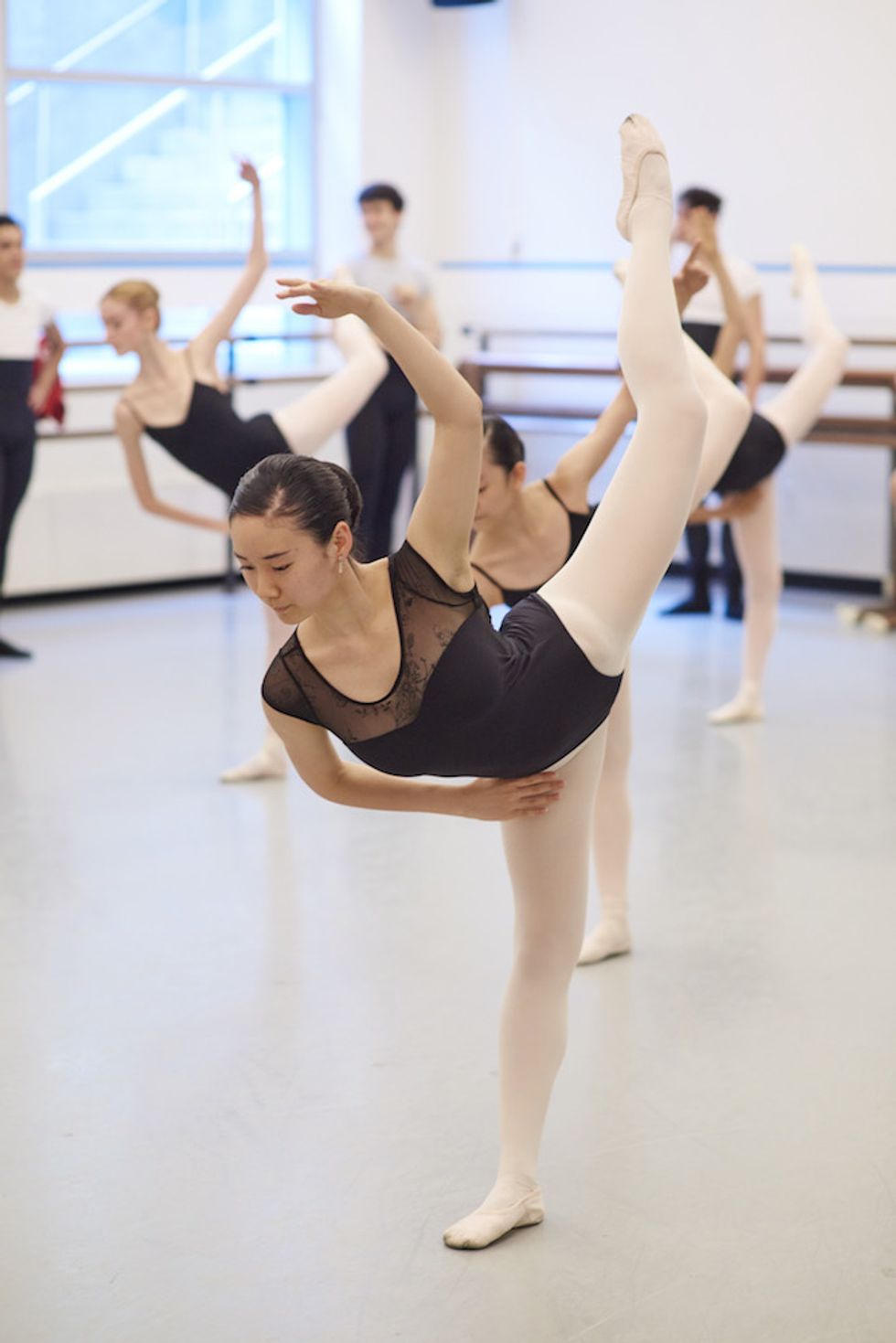
Edward Ellison shapes his students like clay. If a leg needs more turnout, he rotates it and drops the hip into place. If a torso is off-kilter, he pokes and lifts until everything’s aligned. During combinations, he watches with intense focus, and when someone pulls off a difficult step or sequence, he radiates pride. His dedication to both his pupils and the Vaganova technique he teaches is evident in his every word and gesture.
Ellison has long been known as a master teacher, but since he launched his own school in 2005, his reputation for excellence has only grown. Ellison Ballet is small by design—during the year, there are usually between 30 and 40 students, while the summer intensives draw 175 to 200—but the school’s output rivals that of larger, more famous academies. Ellison only accepts the best of the best, dancers who show potential that he’s confident he can shape into something spectacular. That attitude pays dividends; his students dominate at major ballet competitions, and his graduates perform with top-tier companies around the world.
“We expect a lot from our students,” Ellison says. “I believe they can achieve something extraordinary, but to achieve the extraordinary takes extraordinary work. How much you want that end result will show in what you do every day.” Given his complete commitment to his students, he could just as easily be speaking about himself.
An Unconventional Start
Before Ellison did his first tendu, he was a champion break-dancer. When he was 18, a fellow street dancer convinced him to take a summer intensive at a studio in San Diego, to try other dance styles.
“Ballet fascinated me,” he says. “I would look at what the advanced boys were doing, and it was very exciting. And yet, in the beginning class, we weren’t trying to do those jumps and turns. We were standing at the barre while the teacher corrected our stance. As an athlete and a break-dancer, I’d never experienced anything like it.”
Interest piqued, he signed on for year-round training. In addition to his beginner classes, he was invited to study with Marius Zirra, a Romanian who’d trained in St. Petersburg, Russia, and defected to the U.S. Ellison spent the next two years immersing himself in ballet, and when Zirra left the school, he searched for a teacher who would be equally knowledgeable and passionate about ballet. He briefly landed at Houston Ballet Academy, and after only five months was offered a company apprenticeship, which he turned down in favor of further training.

At San Francisco Ballet School, Ellison found his next mentor: former Bolshoi Ballet dancer Larisa Sklyanskaya. “She tore us to shreds,” Ellison says, laughing. “She emphasized the use of parts of the body that other teachers weren’t even talking about. The improvements we made in two years with her were remarkable.” At 22, Ellison joined San Francisco Ballet, where he remained for 10 years.
A Surprise Passion
“I honestly never dreamed of being a teacher,” Ellison says. And yet, the first time he was asked to lead a class, he was excited to discover a natural rapport with the students. He had a chance to hone his pedagogy during his final year with SFB. While on injury leave, he asked Sklyanskaya if he could observe her classes. Soon, he’d accumulated stacks of notebooks. “I wrote down every combination, every correction, every metaphor,” he says. “When Sklyanskaya saw how serious I was, she started asking me to give corrections and create combinations.”

Ellison leads a session of his summer intensive at Manhattan Movement and Arts Center.
When he left the company, Ellison took a teaching job at SFBS. But it wasn’t long before he felt like he needed a change of scenery. He moved to New York City in 1997 and spent a few years teaching open classes, including at Steps on Broadway and Peridance. He also led company classes at American Ballet Theatre, Alvin Ailey American Dance Theater and the Metropolitan Opera Ballet, and he offered private lessons. Still, he wanted to do more.
An Impossible Dream
Ellison clearly recalls the December 2004 day when the seed that would become Ellison Ballet was planted. “I was in the hallway at Steps,” he says, “and I mentioned to a friend that I was frustrated. If I wanted to really instill my knowledge, I needed to see my students for more hours, every single day. My friend told me, ‘Start a school.'”
As with each turning point in his life, Ellison jumped in straightaway, but not everyone around him was supportive. “The more people I spoke to, the more I learned why I was going to fail!” he says. “I didn’t have money or backers. How could I hope to compete with the major schools in the city? People also said, ‘You’re moving too fast. Wait a year.’ But I felt momentum. I had to try.”

In 2005, his first summer intensive attracted 22 students. Ten girls signed on for his first full year of classes, held at New Dance Group in Manhattan. Ellison wasn’t at all disappointed by the small turnout. “I wanted to have a selective school,” he explains. “I wasn’t going to accept someone just because they could pay the tuition.” The operation was bare-bones, but the dancers were hungry. Some had even left prestigious academies to study with Ellison.
The biggest roadblock in those early years was studio space. In 2008, Ellison learned that New Dance Group was closing its doors. He was given one month to relocate. “For the next year and a half, we jumped from studio to studio,” he says. “Some days we’d start at 11 am, and other days at 3 pm.” He was working around the clock and barely earning a salary, but he was convinced that the school would land on its feet. In the meantime, the talent kept showing up.
A Philosophy That Works
Ellison Ballet has been based at Manhattan Movement and Arts Center since 2011. Dancers ages 12 to 19 are split into junior girls, senior girls and a boys’ class. They’re in the studio from 10:30 to 4:30 daily, studying ballet technique, pointe, pas de deux, variations and contemporary. Many also have private coaching with Ellison. (Academics are completed online.)
Ellison’s approach is steeped in the Vaganova method his mentors shared with him. “The Vaganova style is so pure and logical,” he says. “It’s designed to show your deficiencies, not to disguise them. You’re forced to be honest with yourself.” He believes hands-on corrections are essential, and he has students and parents sign a document acknowledging that Ellison Ballet is a hands-on school. “When you have a teacher manipulating your body,” he explains, “you’re able to feel muscles engage that you didn’t feel before. Teaching only through verbiage and demonstration is simply not as effective.” He tends to repeat class material for several days, giving students a chance to dig in without having to memorize new combinations, and he doesn’t hesitate to stop mid-phrase to point out errors. He’s exacting, and it’s clear everyone in the room relishes the challenge.

Ellison with full-time student Keaton Gillespie
His students often medal at competitions, but he’s quick to stress that winning isn’t the goal: “Competing is an invaluable learning experience. You’re taking choreography that was created on principal dancers. It’s difficult technically, stylistically and artistically. You have to learn the character and the context of the ballet. The preparation can be very intense, and the growth you see—it’s beautiful.”
Graduates of the program leave with far more than stellar technique and rich artistry. “Mr. Ellison’s energy is captivating, and it forces you to match him,” says Melissa Chapski, who studied at Ellison Ballet from 2013 to 2015, and now performs with Dutch National Ballet. She still returns to train with Ellison each summer. “When I first joined, I never got away with standing in the back. He had me working on something every second. If I saw someone working more than me, I wasn’t doing enough.”
“He instills so much discipline,” says Adrian Blake Mitchell, who trained at Ellison Ballet from 2012 to 2014 and is currently with the Mikhailovsky Theatre in St. Petersburg. “In a company, there’s no one who is invested in you the same way your teacher is when you’re a student. No one can succeed for you.”
Ellison elaborates: “One of the hallmarks of an Ellison Ballet graduate is their preparedness. It’s not about what our dancers are going to get out of being in a company. It’s about what they’re going to give. That means developing an awareness of how you’re taking in information. It’s not letting yourself receive the same correction multiple times. It’s being willing to go the extra mile.”
In the end, that’s Ellison’s vision: dancers whose technical skill and artistic expression are exceeded only by their sense of responsibility. “My students may go on to make quite a contribution to this art,” he says, “but only if they see ballet as something of great value. That’s why I give them everything I can.”




